Optimization Model for Sustainable End-of-Life Vehicle Processing and Recycling
Abstract
1. Introduction
2. Proposed Network Superstructure
2.1. Optimization Model
2.1.1. Problem Statement
2.1.2. Problem Representation
2.2. Model Formulation
2.2.1. Model Constraints
2.2.2. Network Revenues
2.2.3. Network Expenses
2.2.4. End-of-Life Vehicle Greenhouse Gas Emissions
2.2.5. Objective Function and the MILP Model
3. Case Study in Qatar
3.1. Model Data
3.2. Model Results
3.3. Sensitivity Analysis
4. Conclusions
Author Contributions
Funding
Institutional Review Board Statement
Informed Consent Statement
Data Availability Statement
Conflicts of Interest
Nomenclature
| Indices | ||
| b | vehicle’s battery materials | |
| f | vehicle’s fluids | |
| g | network component/nodes | |
| g′ | network component/nodes | |
| h | type of material/part | |
| i | type of collection point | |
| j | type of dismantling facility | |
| k | type of processing facility | |
| m | type of market | |
| o | vehicle’s other material | |
| t | vehicle’s tire material | |
| V | type of vehicle | |
| n | disposable and hazardous material index | |
| Sets’ Elements | ||
| ACo | aluminum company | |
| al | aluminum | |
| bf | battery fluid | |
| BARC | battery-recycling company | |
| bt | battery | |
| cf | cfc-hfc fluid | |
| co | coolant | |
| cu | copper | |
| dc | disposal center | |
| de | diesel engine vehicles | |
| eo | engine oil | |
| fi | fiber | |
| Fl (Fluid) | fluids market | |
| ga | gasoline | |
| GCo | glass company | |
| ge | gasoline engine vehicles | |
| gl | glass | |
| hz | hazardous materials | |
| MK | commercialization markets | |
| n | vehicle’s non-recyclable material | |
| nr | non-recyclable materials | |
| OM | other materials | |
| ot | other materials market | |
| pb | lead | |
| PCo | plastic company | |
| pl | plastic | |
| pt | platinum | |
| RP | reusable parts market | |
| ru | rubber | |
| SCo | steel company | |
| sh | secondhand market | |
| st | steel | |
| to | transmission oil | |
| tr | tire | |
| TRC | Tire-recycling company | |
| vf | vehicle fluids | |
| Continuous Variables | ||
| BRv,g | vth vehicle’s battery sent to gth node | (tonne/y) |
| BRCv,b,g | vth vehicle’s material b sent to gth node | (tonne/y) |
| CPv,i | number of vehicles v sent to collection point i | (tonne/y) |
| DFv,i,j | vehicles v sent from ith collection point to jth dismantling facility | (tonne/y) |
| DISTg,g′ | transport distance between nodes g and g′ | (km) |
| EXD | expenses incurred by disposing of non-recyclable and hazardous materials | (USD/year) |
| EXNODE | fixed and variable expenses associated with the network components | (USD/year) |
| EXTRANSv,h,g,g′ | expenses from transporting material h of vth vehicle from node g to g′ | (USD/year) |
| FLv,f,j,m | vth vehicle’s material f sent from jth dismantling facility to mth market | (tonne/y) |
| FLOWMATv,h,g,g′ | flow of material h of vth vehicle from network component g to g′ | (tonne/y=) |
| GHGPF | total GHG emissions generated by the processing plants | (tonne CO2 eq./y) |
| GHGTRANS | total material transport GHG emissions | (tonne CO2 eq./y) |
| MATERIALv,h,j | yield of material h from vth vehicle at dismantling facility j | (tonne/y) |
| MFh,g | mass flowrate of material h going through the gth network component | (tonne/y) |
| OMv,o,j,m | vth vehicle’s material o sent from jth dismantling facility to mth market | (tonne/y) |
| PFv,h,j,k | vehicle’s v material h sent from jth dismantling facility to kth processing facility | (tonne/y) |
| REVM | revenue from selling vehicle’s recycled materials | (USD/y) |
| REVP | revenue from selling vehicle’s recycled parts | (USD/y) |
| RPv,h,j,m | vehicle’s v type of material h sent from jth dismantling facility to mth market | (tonne/y) |
| SAVEDGHG | total saved greenhouse gas (GHG) emissions associated with the end-of-life vehicle network | (tonne CO2 eq./y) |
| SHv,i,m | secondhand vehicles v sent from collection point i to market m | (tonne/y) |
| TOTGHG | network’s total GHG emissions | (tonne CO2 eq./y) |
| TOTRANS | total transport cost | (USD/y) |
| TRv,g | vth vehicle’s tires sent to gth node | (tonne/y) |
| TRCv,t,g | vth vehicle’s material t sent to gth node | (tonne/y) |
| Binary Variables | ||
| Bg | 1 if network component g is selected; | |
| 0 otherwise | ||
| Parameters | ||
| BFD | battery fluid mass density | (tonne/L) |
| BFP | battery fluid selling price | (USD/L) |
| BMPb | selling price for recycled battery material b | (USD/tonne) |
| BRCPb,g | percentage of material b send to gth node | (%) |
| BRPg | share of batteries send to gth node | (%) |
| maximum installed capacity of gth network component per material type h | (tonne/y) | |
| minimum installed capacity of gth network component per material type h | (tonne/y) | |
| DEX | expenses associated with the disposal of non-recyclable materials | (USD/tonne) |
| DISTg,g′ | transport distance between nodes g and g′ | (km) |
| DPFk | kth processing facility’s savings due to usage of recycled material as feedstock | (USD/tonne) |
| FCg | fixed expenses associated with the gth network component | (USD/year) |
| FLPv,f,m | share of material f from vehicle v send to mth market | (%) |
| FPf | selling price of vehicle’s fluid f | (USD/L) |
| GHGk | unit GHG emissions rate to make products from virgin materials in the kth processing facility | (tonne CO2 eq./tonne) |
| HEX | expenses associated with the disposal of hazardous materials | (USD/tonne) |
| MASSv,h | mass of material/part h in the vth vehicle | (tonne/material) or (tonne/part) |
| MPh,m | selling price for final product h at mth market | (USD/tonne) |
| NVv | total number of vehicles type v sent to all collection points | (tonne/y) |
| OMPo | selling price for other recycled materials o | (USD/tonne) |
| OMPPv,o,m | share of material o from vehicle v sent to mth market | (%) |
| PFPv,h,k | type of material h from vehicle v sent to processing facility k | (%) |
| PRICEv,h | price of material/part h in the vth vehicle (USD/material) or | (USD/part) |
| RPPv,h,m | type of material h from vehicle v send to market m | (%) |
| SGHGk | saved GHG emissions rate from recycling materials in the kth processing facility | (tonne CO2 eq./tonne) |
| SHPv,i,m | share of vehicles v sent from collection point i to market m | (%) |
| TCg,g′ | transport cost per distance travelled between nodes g and g′ | (USD/km) |
| TMPt | selling price for recycled tire material t | (USD/tonne) |
| TRCPt,g | percentage of material t send to gth node | (%) |
| TRPg | share of tires send to gth node | (%) |
| UGHGg,g′ | unit transport GHG emissions from node g to g′ | (tonne CO2 eq./km) |
| UTCg,g′ | unit transport cost from node g to g′ | (USD/tonne/km) |
| VCPi | ith collection point’s variable expenses | (USD/tonne) |
| VDFj | jth dismantling facility’s variable expenses | (USD/tonne) |
| VMv | mass of vehicle v | (tonne/vehicle) |
| VPv | selling price of vehicle v | (USD/y) |
| VPFk | kth processing facility’s variable expenses | (USD/tonne) |
| YIELDPv,h | yield of material h from vth vehicle | (%) |
| YPk | product yield for the kth processing plant | (%) |
| ρf | mass density of fluid f | (tonne/L) |
Appendix A
| Nodes | In-Flow/Out-Flow |
| SM: Secondhand Market |  |
| DF: Dismantling Facility | 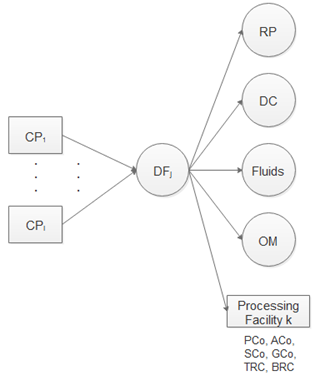 |
| RP: Reusable Parts | 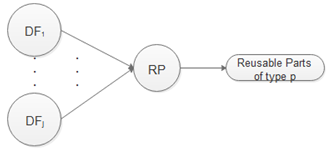 |
| Fluids: Fluids |  |
| OM: Other Materials | 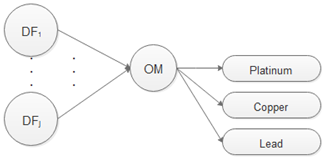 |
| TRC: Tire-Recycling Company | 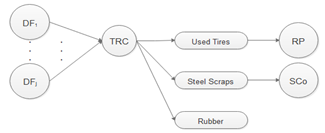 |
| BARC: Battery-Recycling Company |  |
References
- United Nations. Arsenic and the 2030 Agenda for Sustainable Development. In Arsenic Research and Global Sustainability, Proceedings of the 6th International Congress Onarsenic in the Environment, Stockholm, Sweden, 19–23 June 2016; Routledge: Stockholm, Sweden, 2016. [Google Scholar]
- Ehrenfeld, J.; Gertler, N. Industrial Ecology in Practice: The Evolution of Interdependence at Kalundborg. J. Ind. Ecol. 1997, 1, 67–79. [Google Scholar] [CrossRef]
- Gómez, A.M.M.; González, F.A.; Bárcena, M.M. Smart eco-industrial parks: A circular economy implementation based on industrial metabolism. Resour. Conserv. Recycl. 2018, 135, 58–69. [Google Scholar] [CrossRef]
- De Almeida, S.T.; Borsato, M. Assessing the efficiency of End of Life technology in waste treatment—A bibliometric literature review. Resour. Conserv. Recycl. 2019, 140, 189–208. [Google Scholar] [CrossRef]
- Zhang, L.; Yuan, Z.; Bi, J.; Liu, B. Eco-industrial parks: National pilot practices in China. J. Clean. Prod. 2010, 18, 504–509. [Google Scholar] [CrossRef]
- Boix, M.; Montastruc, L.; Azzaro-Pantel, C.; Domenech, S. Optimization methods applied to the design of eco-industrial parks: A literature review. J. Clean. Prod. 2015, 87, 303–317. [Google Scholar] [CrossRef]
- Diener, D.L.; Tillman, A. Resources, Conservation and Recycling Scrapping steel components for recycling—Isn’t that good enough? Seeking improvements in automotive component end-of-life. Resour. Conserv. Recycl. 2016, 110, 48–60. [Google Scholar] [CrossRef]
- d’Ambrières, W. Plastics Recycling Worldwide: Current Overview and Desirable Changes. 2019. Available online: https://www.oneplanetnetwork.org/sites/default/files/from-crm/factsreports-5102.pdf (accessed on 1 August 2021).
- Saavedra, Y.M.B.; Iritani, D.R.; Pavan, A.L.R.; Ometto, A.R. Theoretical contribution of industrial ecology to circular economy. J. Clean. Prod. 2018, 170, 1514–1522. [Google Scholar] [CrossRef]
- Saidani, M.; Kendall, A.; Yannou, B.; Leroy, Y.; Cluzel, F. Management of the end-of-life of light and heavy vehicles in the U.S.: Comparison with the European union in a circular economy perspective. J. Mater. Cycles Waste Manag. 2019, 21, 1449–1461. [Google Scholar] [CrossRef]
- Despeisse, M.; Kishita, Y.; Nakano, M.; Barwood, M. Towards a circular economy for End-of-Life Vehicles: A comparative study UK–Japan. Procedia CIRP 2015, 29, 668–673. [Google Scholar] [CrossRef]
- Gu, C.; Leveneur, S.; Estel, L.; Yassine, A. Modeling and optimization of material/energy flow exchanges in an eco-industrial park. Energy Procedia 2013, 36, 243–252. [Google Scholar] [CrossRef]
- Chertow, M.R. Uncovering’ Industrial Symbiosis. J. Ind. Ecol. 2007, 11, 11–30. [Google Scholar] [CrossRef]
- Piaszczyk, C. Model Based Systems Engineering with Department of Defense Architectural Framework. Syst. Eng. 2011, 14, 305–326. [Google Scholar] [CrossRef]
- Behera, S.K.; Kim, J.H.; Lee, S.Y.; Suh, S.; Park, H.S. Evolution of ‘designed’ industrial symbiosis networks in the Ulsan Eco-industrial Park: ‘Research and development into business’ as the enabling framework. J. Clean. Prod. 2012, 29–30, 103–112. [Google Scholar] [CrossRef]
- Tessitore, S.; Daddi, T.; Iraldo, F. Eco-industrial parks development and integrated management challenges: Findings from Italy. Sustainability 2015, 7, 10036–10051. [Google Scholar] [CrossRef]
- Mat, N.; Cerceau, J.; Shi, L.; Park, H.S.; Junqua, G.; Lopez-Ferber, M. Socio-ecological transitions toward low-carbon port cities: Trends, changes and adaptation processes in Asia and Europe. J. Clean. Prod. 2016, 114, 362–375. [Google Scholar] [CrossRef]
- Aid, G.; Eklund, M.; Anderberg, S.; Baas, L. Expanding roles for the Swedish waste management sector in inter-organizational resource management. Resour. Conserv. Recycl. 2017, 124, 85–97. [Google Scholar] [CrossRef]
- Susur, E.; Hidalgo, A.; Chiaroni, D. A strategic niche management perspective on transitions to eco-industrial park development: A systematic review of case studies. Resour. Conserv. Recycl. 2019, 140, 338–359. [Google Scholar] [CrossRef]
- Chertow, M.R. Industrial symbiosis: Literature and taxonomy. Annu. Rev. Energy Environ. 2000, 25, 313–337. [Google Scholar] [CrossRef]
- Haskins, C. A Systems Engineering Framework for Eco–Industrial Park Formation. Syst. Eng. 2007, 10, 83–97. [Google Scholar] [CrossRef]
- Felicio, M.; Amaral, D.; Esposto, K.; Durany, X.G. Industrial symbiosis indicators to manage eco-industrial parks as dynamic systems. J. Clean. Prod. 2016, 118, 54–64. [Google Scholar] [CrossRef]
- European Parliament and Council. Directive 2000/53/EC on End-of-Life Vehicles. Off. J. Eur. Union 2000, L269, 34–42.
- Tian, J.; Chen, M. Sustainable design for automotive products: Dismantling and recycling of End-of-Life Vehicles. Waste Manag. 2014, 34, 458–467. [Google Scholar] [CrossRef] [PubMed]
- SIR. 2013 Steel Recycling Rates; SIR: Pittsburg, PA, USA, 2013. [Google Scholar]
- SRI. Steel Recycling Institute Turns 25; SRI: Pittsburgh, PA, USA, 2013. [Google Scholar]
- Sakai, S.; Yoshida, H.; Hiratsuka, J.; Vandecasteele, C.; Kohlmeyer, R.; Rotter, V.S.; Passarini, F.; Santini, A.; Peeler, M.; Li, J.; et al. An international comparative study of end-of-life vehicle (ELV) recycling systems. J. Mater. Cycles Waste Manag. 2014, 16, 1–20. [Google Scholar] [CrossRef]
- Vermeulen, I.; van Caneghem, J.; Block, C.; Baeyens, J.; Vandecasteele, C. Automotive shredder residue (ASR): Reviewing its production from End-of-Life Vehicles (ELVs) and its recycling, energy or chemicals’ valorisation. J. Hazard. Mater. 2011, 190, 8–27. [Google Scholar] [CrossRef] [PubMed]
- Li, Y.; Fujikawa, K.; Wang, J.; Li, X.; Ju, Y.; Chen, C. The potential and trend of end-of-life passenger vehicles recycling in China. Sustainability 2020, 12, 1455. [Google Scholar] [CrossRef]
- Saidani, M.; Yannou, B.; Leroy, Y.; Cluzel, F. Dismantling, remanufacturing and recovering heavy vehicles in a circular economy—Technico-economic and organisational lessons learnt from an industrial pilot study. Resour. Conserv. Recycl. 2020, 156, 104684. [Google Scholar] [CrossRef]
- Soo, V.K.; Peeters, J.; Compston, P.; Doolan, M.; Duflou, J.R. Comparative Study of End-of-Life Vehicle Recycling in Australia and Belgium. Procedia CIRP 2017, 61, 269–274. [Google Scholar] [CrossRef]
- Karagoz, S.; Aydin, N.; Simic, V. End-of-life vehicle management: A comprehensive review. J. Mater. Cycles Waste Manag. 2020, 22, 416–442. [Google Scholar] [CrossRef]
- Simic, V.; Branka, D.S.; Branislava, R.V. Closed-Loop Supply Chain of End-of-Life Vehicles. In Proceedings of the XIX International Conference on Material Handling, Constructions and Logistics’09, Belgrade, Serbia, 15–16 October 2009; pp. 189–194. [Google Scholar]
- Özceylan, E.; Demirel, N.; Çetinkaya, C.; Demirel, E. A closed-loop supply chain network design for automotive industry in Turkey. Comput. Ind. Eng. 2017, 113, 727–745. [Google Scholar] [CrossRef]
- Demirel, E.; Demirel, N.; Gökçen, H. A mixed integer linear programming model to optimize reverse logistics activities of End-of-Life Vehicles in Turkey. J. Clean. Prod. 2016, 112, 2101–2113. [Google Scholar] [CrossRef]
- Simic, V. End-of-life vehicle recycling-a review of the state-of-the-art. Recikliranje Vozila Kraj. Životnog Ciklusa-Pregl. Najsuvremnijih Znan. Rad. 2013, 20, 371–380. [Google Scholar]
- Planning and Statistics Authority. Quarterly Bulletin Population Statistics; Planning and Statistics Authority: Doha, Qatar, 2020.
- Al-quradaghi, S.; Zheng, Q.P.; Elkamel, A. Generalized Framework for the Design of Eco-Industrial Parks: Case Study of End-of-Life Vehicles. Sustainability 2020, 12, 6612. [Google Scholar] [CrossRef]
- Rogers, D.S.; Tibben-Lembke, R.S. Going Backwards: Reverse Logistics Trends and Practices; Reverse Logistics Executive Council: Pittsburgh, PA, USA, 1999. [Google Scholar]
- Kuşakcı, A.O.; Ayvaz, B.; Cin, E.; Aydın, N. Optimization of reverse logistics network of End of Life Vehicles under fuzzy supply: A case study for Istanbul Metropolitan Area. J. Clean. Prod. 2019, 215, 1036–1051. [Google Scholar] [CrossRef]
- Simic, V. A multi-stage interval-stochastic programming model for planning End-of-Life Vehicles allocation. J. Clean. Prod. 2016, 115, 366–381. [Google Scholar] [CrossRef]
- Choi, J.; Stuart, J.A.; Ramani, K. Modeling of Automotive Recycling Planning in the United States. Int. J. Automot. Technol. 2005, 6, 413–419. [Google Scholar]
- Simic, V.; Dimitrijevic, B. Interval linear programming model for long-term planning of vehicle recycling in the Republic of Serbia under uncertainty. Waste Manag. Res. 2015, 33, 114–129. [Google Scholar] [CrossRef]
- van Schaik, A.; Reuter, M.A. The optimization of end-of-life vehicle recycling in the European Union. JOM 2004, 56, 39–43. [Google Scholar] [CrossRef]
- Phuc, P.N.K.; Yu, V.F.; Tsao, Y.C. Optimizing fuzzy reverse supply chain for End-of-Life Vehicles. Comput. Ind. Eng. 2017, 113, 757–765. [Google Scholar] [CrossRef]
- D’Adamo, I.; Gastaldi, M.; Rosa, P. Recycling of End-of-Life Vehicles: Assessing trends and performances in Europe. Technol. Forecast. Soc. Chang. 2020, 152, 119887. [Google Scholar] [CrossRef]
- Cruz-rivera, R.; Ertel, J. Reverse logistics network design for the collection of End-of-Life Vehicles in Mexico. Eur. J. Oper. Res. 2009, 196, 930–939. [Google Scholar] [CrossRef]
- Cin, E.; Kusakcı, A.O. A Literature Survey on Reverse Logistics of End of Life Vehicles. Southeast Eur. J. Soft Comput. 2017, 6, 31–39. [Google Scholar] [CrossRef][Green Version]
- ARDP. Auto Recycling Demonstration Project; ARDP: Ann Avbobr, MI, USA, 1998. [Google Scholar]
- Edwards, C.; Bhamra, T.; Rahimifard, S. A Design Framework for End-of-Life Vehicle Recovery. In Proceedings of the 13th CIRP International Conference on Life Cycle Engineering, Leuven, Belgium, 31 May–2 June 2006; pp. 365–370. [Google Scholar]
- Wang, L.U.; Chen, M. End-of-Life Vehicle Dismantling and Recycling Enterprises: Developing Directions in China. JOM 2017, 65, 1015–1020. [Google Scholar] [CrossRef]
- ARA. Automotive Recycling Industry: Environmentally Friendly, Market Driven, and Sustainable; ARA: Manassas, VA, USA, 2012. [Google Scholar]
- Cassells, S. Toward Sound Management of End-of-Life Vehicles in New Zealand; Massey University: Palmerston, New Zealand, 2004. [Google Scholar]
- Yu, C.; de Jong, M.; Dijkema, G.P.J. Process analysis of eco-industrial park development-The case of Tianjin, China. J. Clean. Prod. 2014, 64, 464–477. [Google Scholar] [CrossRef]
- Kumar, S.; Yamaoka, T. System dynamics study of the Japanese automotive industry closed loop supply chain. J. Manuf. Technol. Manag. 2007, 18, 115–138. [Google Scholar] [CrossRef]
- Ahmed, S.; Ahmed, S.; Shumon, M.; Quader, M. End-of-Life Vehicles (ELVs) Management and Future Transformation in Malaysia. J. Appl. Sci. Agric. 2014, 9, 227–237. [Google Scholar]

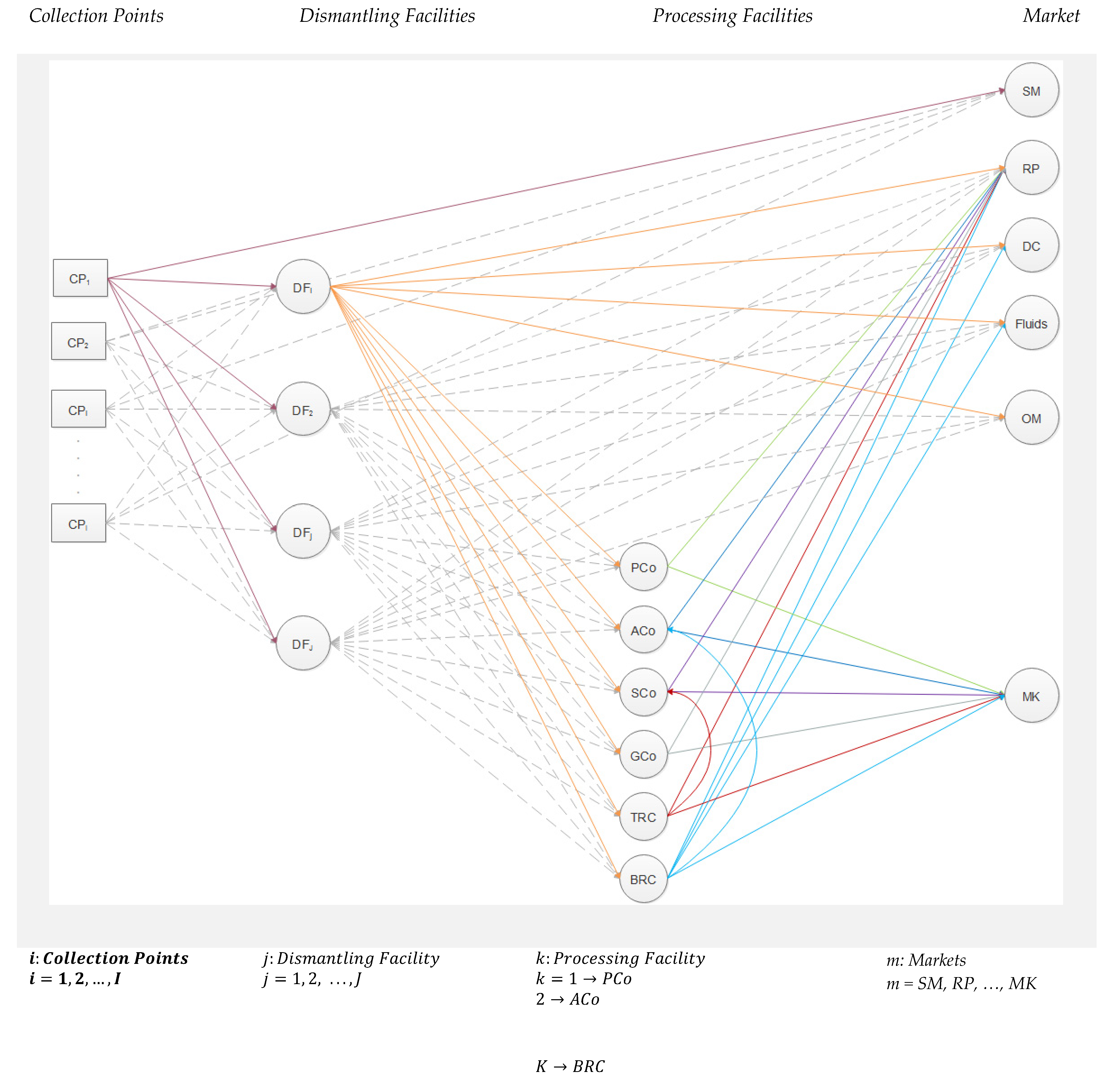

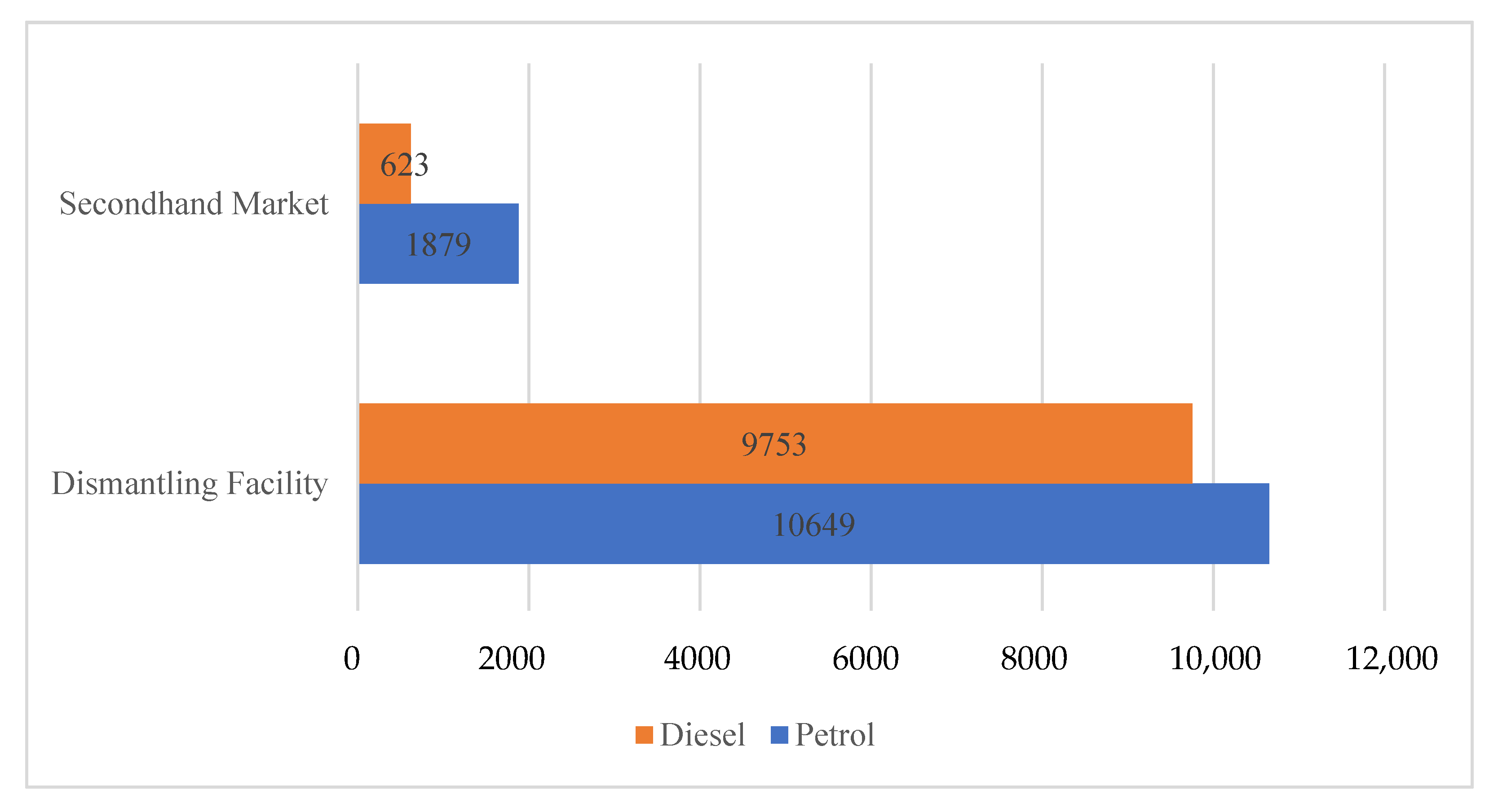
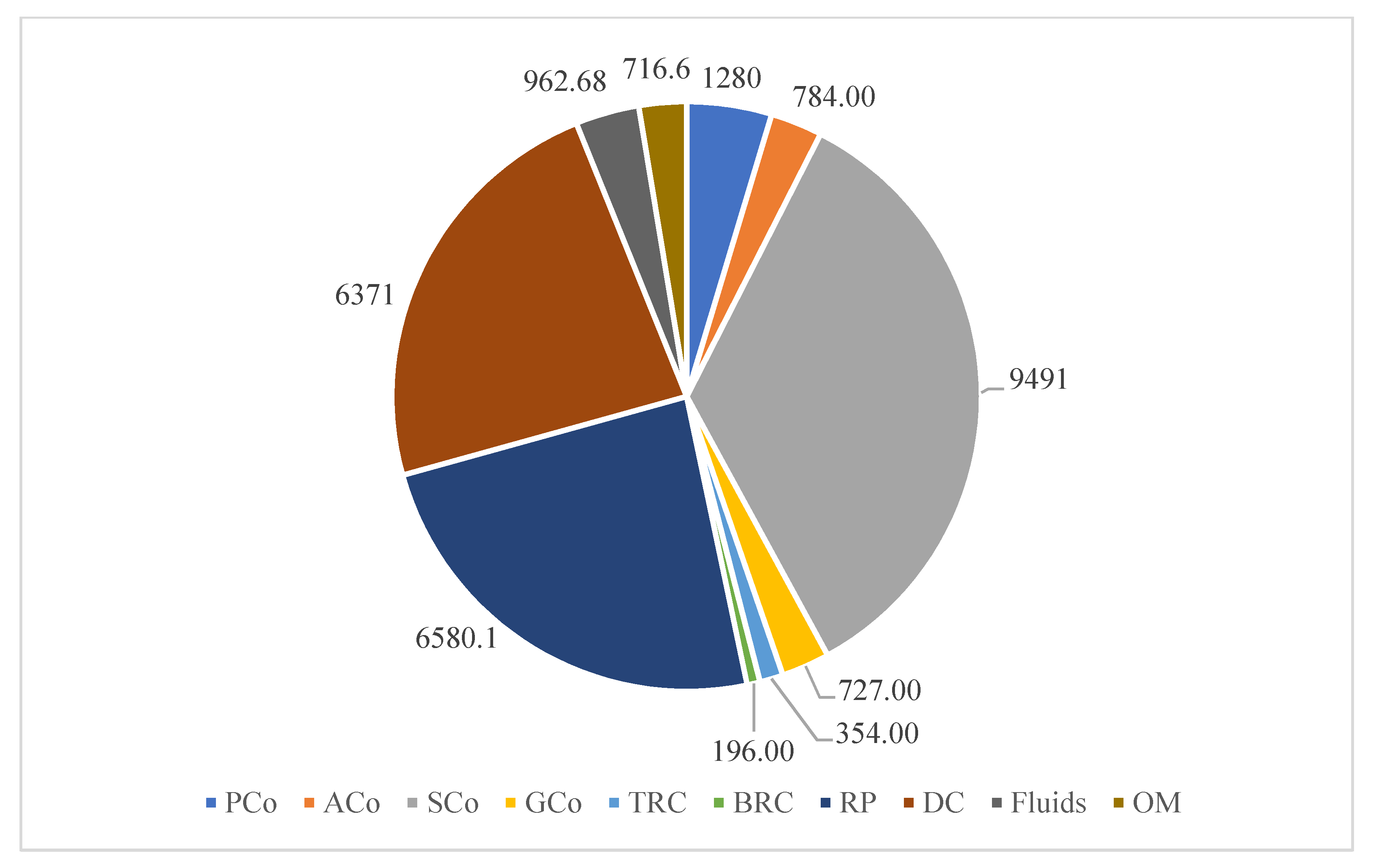
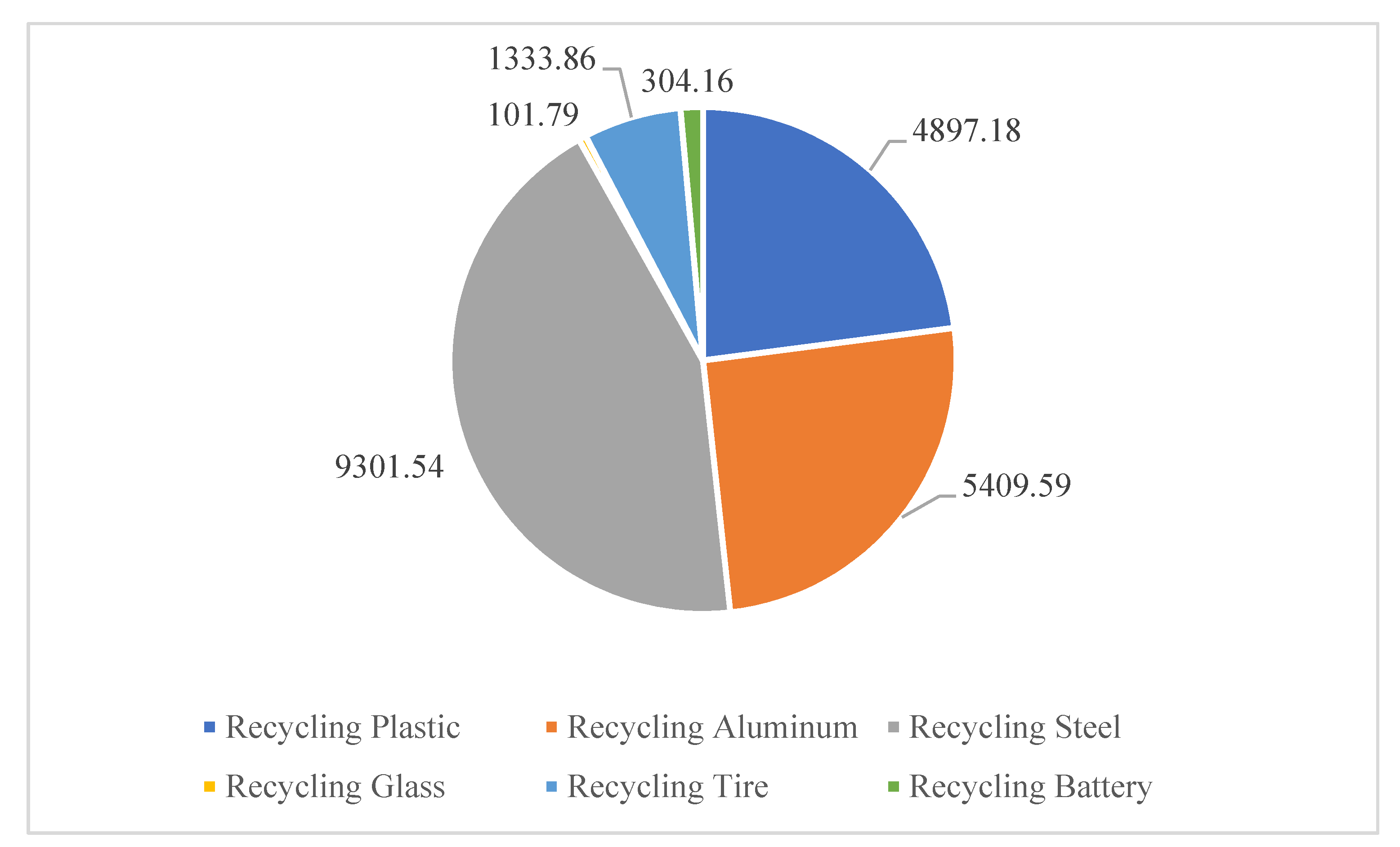

| (USD/Unit) | References | |||||||
|---|---|---|---|---|---|---|---|---|
| V1 | V2 | |||||||
| Used Vehicle | 4000 | 5000 | [38] | |||||
| (USD/L) | ||||||||
| Transmission Oil | Coolant | Engine Oil | Gasoline | CFC-HFC | Battery Fluids | |||
| Used Fluid | 1 | 0.4 | 1.2 | 0.5 | 5 | 0.1 | [2] | |
| USD/tonne | ||||||||
| Plastic | Aluminum | Steel | Glass | Platinum (pt) | Copper (cu) | Lead (pb) | ||
| Scrap Material | 20 | 880 | 22 | 28 | 1180k | 3300 | 880 | [39] |
| USD/tonne | ||||||||
| Plastic | Aluminum | Steel | Glass | |||||
| Finished Material | 140 | 2080 | 166 | 1350 | [39] | |||
| USD/tonne | ||||||||
| Steel | ||||||||
| Scrap from Tires | 169 | [40] | ||||||
| To | PCo | ACo | SCo | GCo | TRC | BARC | SM | |||||||
|---|---|---|---|---|---|---|---|---|---|---|---|---|---|---|
| From | ||||||||||||||
| - | - | - | - | - | - | - | - | - | - | - | - | - | ||
| - | - | - | - | - | - | - | - | - | - | - | - | - | ||
| - | - | - | - | - | - | - | - | - | - | - | - | - | ||
| 6.9 | 1.8 | 8.0 | - | - | - | - | - | - | - | - | - | - | ||
| 5.0 | 9.7 | 3.1 | - | - | - | - | - | - | - | - | - | - | ||
| 9.0 | 7.5 | 10.7 | - | - | - | - | - | - | - | - | - | - | ||
| PCo | - | - | - | 6.8 | 7.8 | 4.1 | - | - | - | - | - | 16.5 | - | |
| ACo | - | - | - | 24.8 | 25.1 | 26.1 | - | - | - | - | - | - | - | |
| SCo | - | - | - | 28.6 | 27.7 | 22.9 | - | - | - | - | 13.8 | - | - | |
| GCo | - | - | - | 8.2 | 4.9 | 4.2 | - | - | - | - | - | - | - | |
| TRC | - | - | - | 23.6 | 18.8 | 19.5 | - | - | - | - | - | - | - | |
| BARC | - | - | - | 24.2 | 20.5 | 17.8 | - | - | - | - | - | - | - | |
| SM | 9.5 | 10.1 | 11.6 | - | - | - | - | - | - | - | - | - | - | |
| RP | - | - | - | 7.1 | 4.7 | 6.9 | 9.0 | 27.4 | 23.5 | 3.9 | 19.9 | 26.5 | - | |
| DC | - | - | - | 6.8 | 6.4 | 2.6 | 3.6 | 22.8 | 24.6 | 1.5 | 17.7 | 19.6 | - | |
| Fluids | - | - | - | 4.4 | 5.0 | 8.2 | - | - | - | - | - | 20.7 | - | |
| OM | - | - | - | 3.6 | 7.6 | 5.7 | - | - | - | - | - | - | - | |
| MK | - | - | - | - | - | - | 4.0 | 24.1 | 23.1 | 3.0 | 19.5 | 18.1 | - | |
| Facility | Capacity (Tonnes/Year) | Reference | |||
|---|---|---|---|---|---|
| Patrol (V1) | Diesel (V2) | Total | |||
| Collection Points | CP1 | 40,000 | 30,000 | 70,000 | [14,21,32,43,44,45] |
| CP2 | 35,000 | 28,000 | 63,000 | ||
| CP3 | 27,000 | 25,000 | 52,000 | ||
| Dismantling Facility | DF1 | 20,000 | 15,000 | 35,000 | |
| DF2 | 15,000 | 20,000 | 35,000 | ||
| DF3 | 10,000 | 16,000 | 26,000 | ||
| Processing Facility | PCo | 2000 | 1600 | 3600 | |
| ACo | 1500 | 1000 | 2500 | ||
| SCo | 15,000 | 10,000 | 25,000 | ||
| GCo | 1000 | 800 | 1800 | ||
| TRC | 800 | 600 | 1400 | ||
| BARC | 600 | 400 | 1000 | ||
| Secondhand Market | 10,000 | 8000 | 18,000 | ||
| Reusable Parts Market | 15,000 | 10,000 | 25,000 | ||
| Disposal Center | 25,000 | 25,000 | 50,000 | ||
| Fluids Market | 10,000 | 10,000 | 20,000 | ||
| Other Materials Market | 5000 | 5000 | 10,000 | ||
| Total Weight (kg) | Iron and Steel | Aluminum | Glass | Plastic | Tires | Battery | Fluids | Other |
|---|---|---|---|---|---|---|---|---|
| Petrol 1240 | 742 | 68 | 40 | 114 | 31 | 14 | 50 | 86 |
| Diesel 1463 | 959 | 72 | 40 | 114 | 31 | 14 | 50 | 86 |
| Average weight (Petrol and Diesel cars) 1352 | 851 | 70 | 40 | 114 | 31 | 14 | 50 | 86 |
| Percentage of material in average passenger car: | 63% | 5% | 3% | 8% | 2% | 1% | 4% | 6% |
| Collection Points | |||||||||
|---|---|---|---|---|---|---|---|---|---|
| CP1 | CP2 | CP3 | |||||||
| Fixed Cost (USD/year) | 1.0 × 106 | 0.90 × 106 | 0.80 × 106 | ||||||
| References | Estimation based on literature | ||||||||
| CP1 | CP2 | CP3 | |||||||
| V1 | V2 | V1 | V2 | V1 | V2 | ||||
| Variable Cost (USD/vehicle) | 10 | 12 | 12 | 11 | 11 | 10 | |||
| References | [32] | ||||||||
| Dismantling Facility | |||||||||
| DF1 | DF2 | DF3 | |||||||
| Fixed Cost (USD/year) | 2.0 × 106 | 1.80 × 106 | 1.60 × 106 | ||||||
| References | Estimation based on literature | ||||||||
| DF1 | DF2 | DF3 | |||||||
| V1 | V2 | V1 | V2 | V1 | V2 | ||||
| Variable Cost (USD/tonne) | 10 | 12 | 11 | 11 | 12 | 10 | |||
| References | [32] | ||||||||
| Processing Facility Processing Cost | |||||||||
| PCo | ACo | SCo | GCo | TRC | BARC | ||||
| Processing Cost (USD/tonne) | 800 | 1300 | 550 | 85 | 155 | 250 | |||
| References | [46] | [47] | [48] | [32] | [49] | [50] | |||
| Processing Facility Discount Cost due to Energy Savings by using Recycled Materials | |||||||||
| PCo | ACo | SCo | GCo | TRC | BARC | ||||
| Discount Cost (USD/tonne) | 445 | 947 | 49 | 3 | 15.5 | 25 | |||
| References | [46] | [47] | [48] | [32] | [49] | [50] | |||
| GHG Emissions Rate to Make Products from… | ||||||
|---|---|---|---|---|---|---|
| PCo | ACo | SCo | GCo | TRC * | BARC * | |
| (metric tonne CO2 eq./metric tonne of final product) | ||||||
| Virgin Materials | 5.94 | 7.5 | 1.3 | 0.68 | 0.21 | 0.604 |
| References | [42] | [51] | [51] | [52] | [53] | [44] |
| PCo | ACo | SCo | GCo | TRC | BARC | |
| (saved metric tonne CO2 eq./metric tonne of product from recycled materials) | ||||||
| Recycling Materials | 4.5 | 6.9 | 0.98 | 0.14 | 4.707 | 1.726 |
| References | [42] | [51] | [51] | [52] | [53] | [44] |
| Vehicles Sent from Collection Point (CP) to Secondhand Market (SM) | (Tonnes/Year) | (Vehicles/Year) |
|---|---|---|
| Petrol (V1) | 2330.25 | 1879 |
| Diesel (V2) | 910.80 | 623 |
| Total vehicles sent to Secondhand Market | 3241.05 | 2502 |
| Vehicles sent from Collection Point (CP) to Dismantling Facility (DF) | (tonnes/year) | (vehicles/year) |
| Petrol (V1) | 13,204.75 | 10,649 |
| Diesel (V2) | 14,269.20 | 9753 |
| Total vehicles sent to Dismantling Facility | 27,473.95 | 20,402 |
| Materials sent from Dismantling Facility to… | (tonnes/year) | |
| Plastic Company (PCo) | 1280 | |
| Aluminum Company (ACo) | 784 | |
| Steel Company (SCo) | 9491 | |
| Glass Company (GCo) | 727 | |
| Tire-Recycling Company (TRC) | 354 | |
| Battery Company (BARC) | 196 | |
| Total amount of materials sent from Dismantling Facility to Processing Facilities | 12,833 | |
| Reusable Parts sent from Dismantling Facility to Reusable Parts market | (tonnes/year) | |
| Plastic | 698 | |
| Aluminum | 428 | |
| Steel | 5177 | |
| Glass | 40 | |
| Tire | 161 | |
| Battery | 86 | |
| Total amount of Reusable Parts sent from Dismantling Facility to Reusable Parts market | 6590.881 | |
| Disposable Material sent from Dismantling Facility to Disposal Center | (tonnes/year) | |
| Petrol (V1) | 3166.37 | |
| Diesel (V2) | 3165.48 | |
| Hazardous Material sent from Dismantling Facility to Disposal Center | ||
| Petrol (V1) | 20.60 | |
| Diesel (V2) | 18.55 | |
| Total amount of Disposal Material sent from Dismantling Facility to Disposal Center | 6370.996 | |
| Total amount of Fluid sent from Dismantling Facilities to Fluids market | 962.68 | |
| Total amount of Other Materials sent from Dismantling Facilities to Other Materials market | 716.66 | |
| Profit from… | (USD/Year) |
|---|---|
| Selling Used Vehicles from Collection Points (CP) to Secondhand Market (SM) | 10,636,110.00 |
| Selling Reusable Parts from Dismantling Facilities (DF) to Reusable Parts (RP) | 268,806.56 |
| Selling Used Tires from Tire-Recycling Companies (TRC) to Reusable Parts (RP) | 108,425.01 |
| Selling Used Batteries from Battery-Recycling Companies (BARC) to Reusable Parts (RP) | 5074.18 |
| Selling Fluids from Dismantling Facilities (DF) and Battery-Recycling Company (BARC) to Fluids market (Fluids) | 1,108,982.08 |
| Selling Scrap Materials from Dismantling Facilities (DF) and Tire-Recycling Company (TRC) and Battery-Recycling Company (BARC) to Processing Facilities (PCo, ACo, SCo, and GCo) | 4,351,027.36 |
| Selling Scrap Materials from Dismantling Facilities (DF) and Battery-Recycling Company (BARC) to Other Market (OM) | 3,535,703.60 |
| (USD/Year) | |
|---|---|
| Expenses from handling and processing disposable materials from dismantling facilities (DF) to Disposal Center (DC) | 51,134.38 |
| Total fixed and operating costs of all collection points | 1,041,783.09 |
| Total fixed and variable costs of all dismantling facilities | 2,024,646.58 |
| Total costs of processing facilities | 5,639,524.08 |
| Total annual transportation cost including raw material/intermediate and final products | 174,065.53 |
| CO2 Emissions from… | (Tonne CO2 Eq./Year) |
|---|---|
| Transportation—assuming Truckload Dry Vans at 45,000 lb capacity | 55.36 |
| Plastic Company (PCo) | 1567.10 |
| Aluminum Company (ACo) | 470.40 |
| Steel Company (SCo) | 3037.24 |
| Glass Company (GCo) | 392.60 |
| Tire-Recycling Company (TRC) | 59.51 |
| Battery Company (BARC) | 106.44 |
| Total Annual CO2 Emissions of the network | 5688.64 |
| Saved CO2 emissions by… | (tonne CO2 eq./year) |
| Recycling Plastic | 4897.18 |
| Recycling Aluminum | 5409.59 |
| Recycling Steel | 9301.54 |
| Recycling Glass | 101.79 |
| Recycling Tire | 1333.86 |
| Recycling Battery | 304.16 |
| Total Saved CO2 Emissions of the network | 21,348.12 |
Publisher’s Note: MDPI stays neutral with regard to jurisdictional claims in published maps and institutional affiliations. |
© 2022 by the authors. Licensee MDPI, Basel, Switzerland. This article is an open access article distributed under the terms and conditions of the Creative Commons Attribution (CC BY) license (https://creativecommons.org/licenses/by/4.0/).
Share and Cite
Al-Quradaghi, S.; Zheng, Q.P.; Betancourt-Torcat, A.; Elkamel, A. Optimization Model for Sustainable End-of-Life Vehicle Processing and Recycling. Sustainability 2022, 14, 3551. https://doi.org/10.3390/su14063551
Al-Quradaghi S, Zheng QP, Betancourt-Torcat A, Elkamel A. Optimization Model for Sustainable End-of-Life Vehicle Processing and Recycling. Sustainability. 2022; 14(6):3551. https://doi.org/10.3390/su14063551
Chicago/Turabian StyleAl-Quradaghi, Shimaa, Qipeng P. Zheng, Alberto Betancourt-Torcat, and Ali Elkamel. 2022. "Optimization Model for Sustainable End-of-Life Vehicle Processing and Recycling" Sustainability 14, no. 6: 3551. https://doi.org/10.3390/su14063551
APA StyleAl-Quradaghi, S., Zheng, Q. P., Betancourt-Torcat, A., & Elkamel, A. (2022). Optimization Model for Sustainable End-of-Life Vehicle Processing and Recycling. Sustainability, 14(6), 3551. https://doi.org/10.3390/su14063551








